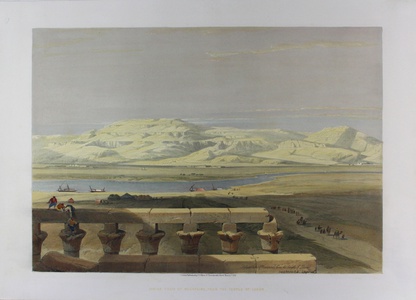| Method | Lithograph with tint stone and later hand colour |
| Artist | Louis Haghe after David Roberts |
| Published | London Published by F. G. Moon 20 Threadneedle Street March 1st 1847 |
| Dimensions | Image 344 x 497 mm, Sheet 430 x 604 mm |
| Notes |
A view of the cliffs bordering the Libyan desert, seen from a colonnade in the archaeological site of Luxor, Egypt. The Arabic town of Luxor stands on the site of the pharaonic New Kingdom capital of Thebes. The city of Thebes included numerous cult shrines and temples, most notably the massive temple complex of the chief god of Thebes, Amun. Despite falling into ruin during the period of Persian control of Egypt, the city experienced a renaissance after the conquest of Alexander the Great. Despite the administration of Egypt being shifted to Alexandria, Thebes remained a critical cultural and religious hub in the Greek and Roman periods. Roberts' view shows the ridges of the Libyan chain, with the ruins of ancient Thebes at their foot. In the middle ground from left to right are the the temple of Rameses III at Medinet Habu, The Colossi of Memnon, and the Ramesseum and temple of Seti I with the Valley of the Kings in the distance. In the middle-distance, numerous boats sail up and down the Nile. On the banks of the river is a large tented campsite, and a long line of travellers and camels wind their way up from the river. In the foreground, the capitals of the colonnade of the Temple of Amenhotep III can be seen, a group of four men climbing up onto the lintels to appreciate the view. David Roberts RA (24 October 1796 – 25 November 1864) David Roberts' monumental works on the Middle East: The Holy Land and Egypt & Nubia, is considered the greatest lithographically illustrated works issued in the 19th century. Roberts' masterpiece was issued in 41 parts over seven years in three states; tinted, tinted proof and coloured and mounted on card. The prints were masterfully lithographed by Louis Haghe, to whom Roberts paid tribute in glowing terms, `Haghe has not only surpassed himself, but all that has hitherto been done of a similar nature. He has rendered the views in a style clear, simple and unlabored, with a masterly vigor and boldness which none but a painter like him could have transferred to stone'. Abbey regarded the work as `one of the most important and elaborate ventures of nineteenth-century publishing, and.the apotheosis of the tinted lithograph'. David Roberts was born in Stockbridge near Edinburgh, and at the early age of 10 apprenticed to Gavin Buego, a house painter. He continued to work for Buego after his apprenticeship had been completed, carrying out work on imitation stonework and paneling at Scone Palace and Abercairney Abbey. By 1818 Roberts had become assistant scene painter at the Pantheon theatre in Edinburgh, moving on to work in theatres in Glasgow and finally in late 1821 to Drury Lane theatre in London, where he worked with Clarkson Stanfield. Both artists exhibited at the Society of British Artists, Royal Academy and British Institution, and by 1830 Roberts was firmly established as a topographical artist and was able to give up his theatre work. In these early years he toured the continent and Scotland, and in 1832-33 visited Spain. In 1838 he made plans for his journey to the Near East, inspired by a love of artistic adventure; departing in August 1839 for Alexandria, he spent the remaining part of the year in Cairo, visiting the numerous tombs and sites. In February of the following year he set out to cross the desert for the Holy Land by way of Suez, Mount Sinai and Petra arriving in Gaza, and then on to Jerusalem, concluding his tour spending several months visiting the biblical sites of the Holy Land, and finally returning to England at the end of 1839. The drawings of his tour were submitted to F.G. Moon in 1840 who arranged to bring out a work illustrative of Scripture History, paying Roberts £ 3,000 for the copyright of the sketches, and for his labour in supervising Louis Haghe's lithography. Both the exhibition of his original watercolours and the subsequent published work were an immediate success and confirmed his reputation as an architectural and landscape artist of the highest order. Abbey Travel 272, 30. Yesterday and Today; Egypt: Plate 67. |
| Framing | unmounted |
| Price | £650.00 |
| Stock ID | 42704 |

